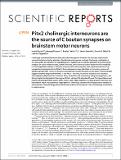Pitx2 cholinergic interneurons are the source of C bouton synapses on brainstem motor neurons
Abstract
Cholinergic neuromodulation has been described throughout the brain and has been implicated in various functions including attention, food intake and response to stress. Cholinergic modulation is also thought to be important for regulating motor systems, as revealed by studies of large cholinergic synapses on spinal motor neurons, called C boutons, which seem to control motor neuron excitability in a task-dependent manner. C boutons on spinal motor neurons stem from spinal interneurons that express the transcription factor Pitx2. C boutons have also been identified on the motor neurons of specific cranial nuclei. However, the source and roles of cranial C boutons are less clear. Previous studies suggest that they originate from Pitx2+ and Pitx2− neurons, in contrast to spinal cord C boutons that originate solely from Pitx2 neurons. Here, we address this controversy using mouse genetics, and demonstrate that brainstem C boutons are Pitx2+ derived. We also identify new Pitx2 populations and map the cholinergic Pitx2 neurons of the mouse brain. Taken together, our data present important new information about the anatomical organization of cholinergic systems which impact motor systems of the brainstem. These findings will enable further analyses of the specific roles of cholinergic modulation in motor control.
Citation
Rozani , I , Tsapara , G , Witts , E C , Deaville , S J , Miles , G B & Zagoraiou , L 2019 , ' Pitx2 cholinergic interneurons are the source of C bouton synapses on brainstem motor neurons ' , Scientific Reports , vol. 9 , 4936 . https://doi.org/10.1038/s41598-019-39996-4
Publication
Scientific Reports
Status
Peer reviewed
ISSN
2045-2322Type
Journal article
Description
IR and LZ were funded by the European Union, Seventh Framework Programme (FP7/2007–2013), by the European Union and Greek National Funds through the operational program “Education and Lifelong Learning” of the National Strategic Reference Framework, funding program: ARISTEIA II, and by Fondation Santé.Collections
Items in the St Andrews Research Repository are protected by copyright, with all rights reserved, unless otherwise indicated.

